Mara MacMahon
MacMahon joined Pixar in 2016 as a character modeler and rigger, and has worked on movies such as Cars 3, Bao, Soul, Turning Red, and Toy Story 4.

Mara MacMahon, AB/BFA ’12 has a knack for balancing the technical and artistic demands of design. As an undergraduate student at WashU, she earned a dual-degree in biology and communication design. “I was figuring out how to combine the two things I really enjoyed,” said MacMahon, “the technical aspects of biology (I was pre-med), along with what I loved about design, illustration, and storytelling.”
Today, she works in the characters department at Pixar, and has contributed to beloved animated movies such as Toy Story 4, Soul, Turning Red, and Cars 3. She works as a modeler, “which is essentially a digital sculptor,” MacMahon said, “I use sketches—almost like a blueprint—to make a digital sculpture of a character, and then add digital controls so animators can pose them and make them move, similar to what you would do with a puppet or action figure.”
One of her favorite projects was working on the pianist, Joe, in the 2020 movie, Soul. “I grew up playing piano, so I really cared that his hands looked accurate,” said MacMahon. “I spent a lot of time and scrutiny on his hands, watching reference videos of pianist Jon Batiste frame by frame, adding controls so that the tendons in Joe’s hands showed up at the right moments.”
“I really appreciated how the Sam Fox School encouraged each artist to figure out what story they wanted to tell and what about themselves they wanted to put into their work.”
At the same time, Soul required a lot of intentional thought and conversation. “It really tied back to the phrase ‘communication design,’” said MacMahon, “We had to really think about cartoons in historical context—how has illustration and caricature been misused in the past? How can we be more intentional about representation? It led to really valuable conversations in our workplace about how we approach design and characters, how we’re conscious of audience perception, and our responsibility to create knowledgeably.”
This balance of technical mastery with thoughtful consideration is what MacMahon loved about WashU and the Sam Fox School. “I really appreciated how the Sam Fox School encouraged each artist to figure out what story they wanted to tell and what about themselves they wanted to put into their work,” said MacMahon. She also shared her appreciation and enjoyment of the studio atmosphere, both at the school and in her career. “There’s such a lively mix of ideas, inspiration, and feedback that makes that shared space so valuable,” she said.
MacMahon’s experience in communication design is broadening her perspective on life and how we interact with the world around us. “The idea that we live and work and breathe in such a visual world—from photography to film to advertisements to games—we often don’t realize that we’re all here to participate in making this world. When we make something, we’re giving others another data point in what to believe or how to respond to the world around them,” she said, “It’s subtle, but so powerful.”
About Mara MacMahon
Mara MacMahon joined Pixar in 2016 as a character modeler/rigger on Cars 3 and Bao, and as both a character designer and modeler/rigger on Toy Story 4. Her work involves digitally sculpting a character based on a designer’s artwork, and adding controls to allow animators to virtually pose the characters and act in shots. She was the character model lead on Soul, Turning Red, and the upcoming release Elio, and character supervisor on a yet-to-be-announced release. MacMahon has also been involved in developing Pixar’s character tracking tool, which breaks down demographics and representation on screen during film production, to aid filmmakers. Prior to Pixar, she worked as a rigging artist in gaming and film studios at TinyCo, Dreamworks, and Toys for Bob. She earned a bachelor of arts in biology and bachelor of fine arts in communication design at Washington University in 2012.
